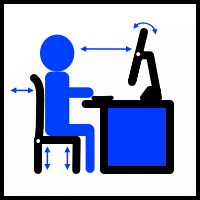|
|
DSE Requirements page 1Send comments on this topic |
FREE QHSE Software Click <HERE> to Learn More |
||
QHSE Support >(Site Map) Health & Safety Guidance > Display Screen Equipment >
DSE Requirements - page 1 of 2
Step 1, - Decide which employees are considered users
In most cases, it will be obvious which employees are classed as DSE 'users' by the nature of their job activities. For example, senior managers are not likely to spend extended periods of time working with DSE, and on occasions when they do, it is unlikely that they cannot take a break from this activity. This is not the case for data input clerks, who may literally spend the entire shift at the DSE terminal.
Where there is doubt as to whether or not the employee is classed as a user, it will be necessary to conduct a more detailed analysis of the person's job descriptions and daily duties. See web page for Display Screen Equipment user check list and self assessment risk assessment for further advice.
Detailed guidance on the criteria applied to 'users' can be found in the HSE publication L26 'Display Screen Equipment Work'.
Step 2, - Carry out Workstation Assessment.
See web page for Display Screen Equipment self assessment risk assessment, which sets out a checklist of areas to examine when conducting a DSE risk assessment. Findings can then be recorded, this should include notes on compliance, as well as any remedial actions required. It also provides the facility for a summary of the assessment findings to be recorded. This will allow the management to have a more efficient method to monitor assessment findings and recommendations and any remedial actions required or implemented.
The DSE risk assessment should be carried out by a suitably trained member of staff or competent consultant.
Step 3, - Reduce the Risk.
The assessment is only of use if the recorded findings of any required remedial actions are used to determine how to reduce or eliminate the risk to the user. It is important to understand that the risk to the user should be reduced to a level which is as low as reasonably practicable.
Elimination or reduction of risks can be a simple matter of asking the user to adjust the height of their chair or use a better working posture, (users with poor working posture should be checked periodically to ensure bad habits do not return). Other remedial actions may require investment in equipment specifically designed for DSE use, e.g. footrests, anti-glare screens, wrist and mouse mats.
Step 4, - Ensure all workstations meet the minimum requirement.
The DSE regulations lays down minimum requirements for all workstations, this covers the following areas.
With regards to Equipment.
•Display screen.
•Keyboard.
•Work desk and surface, and
•Work Chair.
With regards to Environment.
•Space.
•Lighting.
•Reflection and glare.
•Noise.
•Heat.
•Radiation, and
•Humidity.
With regards to Interface between computer and user,
Software should be easy to use and suitable and appropriate to the task. Information should be displayed in a format and at a pace suited to the user.
Related Links
Help file v2.276.407 : QHSE Support - Website On Safe Lines
onsafelines.com QHSE Software 2025 : Webmaster: Brian G. Welch MSc(QHSE), NVQ4(OH&S), CMIOSH



